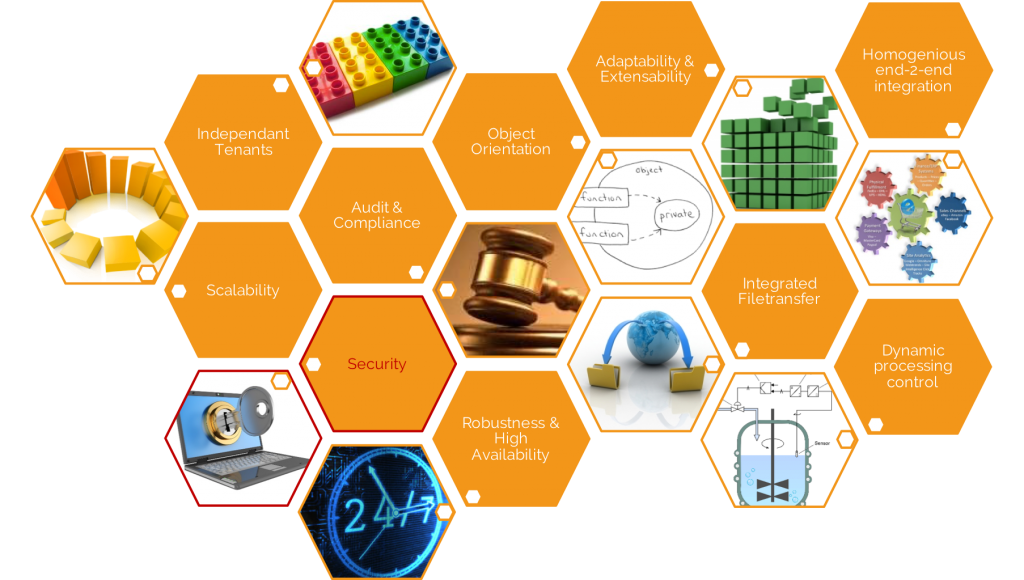Automation Security

Infograph: Automation Security
This post is part of the "Automation-Orchestration" architecture series. Posts of this series together comprise a whitepaper on Automation and Orchestration for Innovative IT-aaS Architectures.
An obvious key point to consider when choosing an automation solution is security. We’ve discussed Audit & Compliance separately from security since audit trails and compliance need the architectural support by the solution but are both less technical in itself compared to security.
Considering security issues for an automation solution means focusing on the following areas:
- Confidentiality: How does the solution manage authorized access?
- Integrity: How does the solution ensure that stored objects and data are consistently traceable at any point in time?
- Availability: How does the solution guarantee availability as defined, communicated, and agreed upon?
- Authenticity: How does the solution ensure the authenticity of identities used for communication of partners (components, objects, users)
- Liability: How does the solution support responsibility and accountability of the organization and its managers?
None of these areas rely on one particular architectural structure. Rather they have to be assessed by reviewing the particular solution’s overall architecture and how it relates to security.
User security
Authentication
Any reputable automation solution will offer industry standard authentication mechanisms such as password encryption, strong password policy, and login protection upon fail. Integrating with common identity directories such as LDAP or AD provides a higher level of security for authenticating user’s access. This allows for the “bind request” to be forwarded to the specific directory and thereby leveraging the directory’s technologies not only to protect passwords and users but also to provide audit trail data for login attempts. Going a step further, an authentication system provided through an external, integrated LDAP might offer stronger authentication – such as MFA – out-of-the-box without the need to augment the solution to gain greater security.
In addition, the solution should provide a customized interface (e.g. provided through an “exit – callback” mechanism) for customers to integrate any authentication mechanism that is not yet supported by the product out-of-the-box.
Personnel data base
Most organizations use one core personnel database within their master data management (MDM) process. For example, new employees are onboarded through an HR-triggered process which, in addition to organizational policies, ensures creation of access permissions to systems that employees use every day. As part of an automation system’s architecture, such an approach involves the need to offer automatically available interfaces and synchronization methods for users – either as objects or links. The automation workflow itself, which supports the HR onboarding process, would subsequently leverage these interfaces to create necessary authentication and authorization artifacts.
Authorization & Access
Enterprise-grade automation solutions should offer a variety of access control for managed objects. In addition to the core capabilities already discussed, IT operations should expect the solution’s support for securing various layers and objects within it. This involves:
- Function level authorization: The ability to grant/revoke permission for certain functions of the solution.
- Object level authorization: The ability to create access control lists (ACLs) at the single object level if necessary.
- ACL aggregation: The ability to group object level ACLs together through intelligent filter criteria in order to reduce effort for security maintenance.
- User grouping: The ability to aggregate users into groups for easy management.
In addition, a secure solution should protect user and group management from unauthorized manipulation through use of permission sets within the authorization system.
API
Automation solutions that do not include APIs are rarely enterprise ready. While compatible APIs (e.g. based on java libraries) would inherently be able to leverage previously discussed security features, Web Service APIs need to offer additional authentication technologies along commonly accepted standards. Within REST, we mainly see three different authentication methods:
- Basic authentication is the lowest security option as it involves simply exchanging a base64 encoded username/password. This not only requires additional security measures for storing, transporting, and processing login information, but it also fails to support authenticating against the API. It also opens external access for any authorized users through passwords only.
- OAuth 1.0a provides the highest level of security since sensitive data is never transmitted. However, implementation of authentication validation can be complex requiring significant effort to set up specific hash algorithms to be applied with a series of strict steps.
- OAuth 2.0 is a simpler implementation, but still considered a sufficiently secure industry standard for API authentication. It eliminates use of signatures and handles all encryption through transport level security (TLS) which simplifies integration.
Basic authentication might be acceptable for an automation solution’s APIs being operated solely within the boundaries of the organization. This is becoming less common as more IT operations evolve into service oriented, orchestrated delivery of business processes operating in a hybrid environment. Operating in such a landscape requires using interfaces for external integration, in which case your automation solution must provide a minimum of OAuth 2.0 security.
Object level security
The levels of authorization previously mentioned set the stage for defining a detailed authorization matrix within the automation solution’s object management layer. An object represents an execution endpoint within a highly critical target system of automated IT operation. Accessing the object representing the endpoint grants permission for the automation solution to directly impact the target system’s behavior. Therefore, an automation system must provide sufficiently detailed ACL configuration methods to control access to:
- Endpoint adapters/agents
- Execution artifacts such as processes and workflows
- Other objects like statistics, reports, and catalogues
- Logical tenants/clients
The list could be extended even further. However, the more detailed the authorization system, the greater the need for feasible aggregation and grouping mechanisms to ease complexity. At the same time, the higher the number of possibilities for controlling and managing authorization, the better the automation solution’s managability.
Separation of concern
Finally, to allow for a role model implementation that supports a typical IT organizational structure, execution must be separated from design and implementation. Object usage must not automatically imply permission for object definition. This allows another automation specialist to access the system to construct workflows with this and other objects without revealing the underlying credentials.
Communication Security
Securing the communication between systems, objects, and endpoints is the final security issue to be considered when assessing an automation solution. This includes
- Encryption
- Remote endpoint authentication – the ability to allow configuration of target endpoints authentication when interacting with the core automation management engine
For communication between components, encryption must be able to leverage standard algorithms. The solution should also allow configuration of the desired encryption method. At minimum, it should support AES-256.
Endpoint authentication provides a view of security from the opposite side of automation. To this point, we’ve discussed how the solution should support security implementation. When a solution is rolled out, however, endpoints need to automatically and securely interact with the automation core. Ideally the automation solution should generate a certification key deployable as a package to endpoint installations. Ideally this would happen via a separate, secure connection. This configuration enables a unique fingerprint for each endpoint and avoids intrusion of untrusted endpoints into the automation infrastructure.




